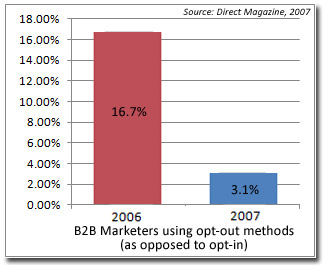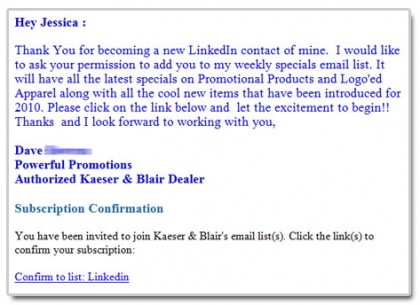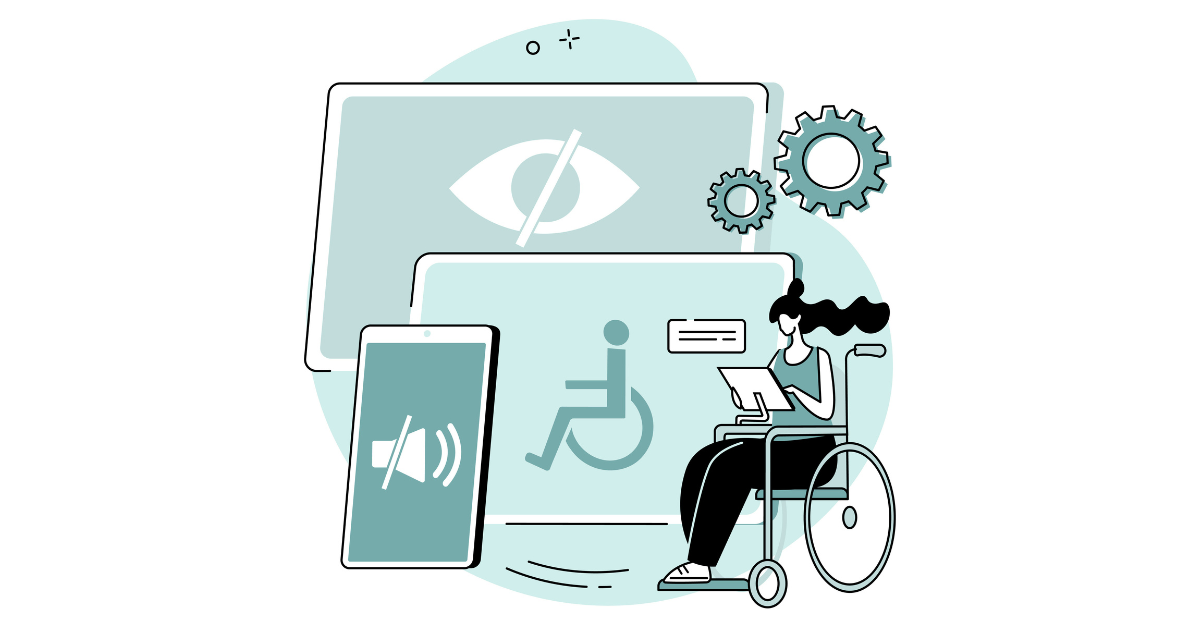We hear email marketers ask all the time: when is it ok to email to a business-to-business prospect? If you want to follow up with prospects after a trade show using your email service provider, can you? Should you automatically add prospects from demos or business meetings to your promotional email list?
 Email marketing professionals will handle these differently, but as always, we think there are some best practices. Business-to-business marketers find it harder to justify a strictly opt-in list. Mostly because (as B2B marketers will admit) not nearly as many people are jumping up and down to receive email marketing about health insurance, as opposed to receiving email offers from their favorite clothing store or restaurant.
Email marketing professionals will handle these differently, but as always, we think there are some best practices. Business-to-business marketers find it harder to justify a strictly opt-in list. Mostly because (as B2B marketers will admit) not nearly as many people are jumping up and down to receive email marketing about health insurance, as opposed to receiving email offers from their favorite clothing store or restaurant.
To answer this question, put yourself in the customer’s shoes – something you hopefully do often. If you go to a tradeshow or see a demo of a product, how do you feel about automatically being added to an email marketing list? It depends, of course, on how relevant the product is to you, the value and frequency of the emails, etc. It may not bother you or it may even be something you end up using.
Overall, though, email has been classified as a type of marketing that if you didn’t sign up for it, you don’t want it. And if you don’t want it, you’re more than willing to hit that nasty spam button. But – here’s the but – as a business person, you do, in fact, need information on health care services and printing capabilities, even if you’re not dying to opt-in to receive information via email.
What are the guidelines on when to send email b-to-b?
Sending marketing or promotional email when sales will email anyway. Your sales staff is going to follow up by email and/or phone on any demos they give or with any leads they receive from a trade show. It makes sense to reach out to those who may be interested in more information about your products. Doing this follow up marketing via your email service provider can offer the same opportunity, but with two key benefits: measurable response – i.e. tracking email views and clicks – and a consistent sales message, rather than each sales person creating a separate email to each prospect. Not to mention, using your email marketing tools instead of Outlook saves your sales people time.
However, opting them in to receive your monthly newsletter or monthly promotional email list without asking is taking a chance on a much lower quality list. Surely you have interesting content, but give your prospects the opportunity to tell you that they want it. Staying true to opt-in best practices will help your reputation both for your email deliverability and for the impression you make on your prospects. When you respect their preferences, you get a more positive response.
Inviting to opt-in or sending a confirmed opt-in message. We encourage a double opt-in list for our marketers. In cases where it fits, it makes for a clean, highly targeted and highly valuable list. A double opt-in being when someone signs up for your email marketing or newsletter and you send them an email to the address they used to sign up. If they click the link in the email confirming their subscription, they’re added to the list. Only after they click the confirmation link do they get added to the email list.
In b-to-b marketing, like the tradeshow scenario or as a follow up to your new social media connections, you can suggest an opt-in using the language from your double opt-in confirmation email. Let’s look at an example.
——– Hi John,
Thank you for adding me as a connection on LinkedIn. I would like to ask your permission to add you to my weekly specials email list. It will have all the latest specials on promotional products and logo’d apparel and announcements of new products and features as they’re introduced. Please click on the link below to confirm and let the excitement to begin!!
Thanks and I look forward to working with you, Jane Smith Acme Apparel
Subscription Confirmation You have been invited to join Acme Product’s email list. Click the following link to confirm your subscription: http://email.acme.com/subscriptionconfirmation ——–
Those interested in hearing about Acme’s new products and receiving discount notifications will click the confirmation link and will know what to expect when they see their first email from Acme. A great way to do this is to set up a batched email marketing campaign to your list of leads from the show or a triggered email to your new Twitter and LinkedIn followers.
Your sales reps don’t have to manually send these invites and your marketing list grows on its own.
Just like the opt-in versus opt-out email marketing debate, you will have a smaller list using these best practices suggestions, but your list will be higher quality with better response rates from people who are expecting to hear from you and a better reputation with the ISPs.
For more a b-to-be email marketing strategy consultation with an emfluence pro, email connect2@emfluence.com.





Thank you for the ‘refresher’ course on opt in email for B2B. I will pass along your article to Amy for our LinkedIn Bootcamp.
Great, thank you for reading and passing along! We get this question many times from customers and industry friends. Feel free to post any additional tips or feedback you may have.
Interesting approach. I had not thought about using LinkedIn for opt-ins.
There is a fantastic discussion circulating on this topic on a guest post at the Harvard Business Review online. The guest blogger has taken quite the opposite stance and it has ignited the email marketing community into response!
Read the article and feel free to add your thoughts below. Here is what our Marketing Manager, Jessica, had to say in response:
I read the guest post on HBR and immediately thought “Well *obviously* that’s not right…” But, really, it isn’t so obvious.
In offline media, people automatically send to anyone who’s information they can validate, let alone if someone hands them a business card. And from a B2B marketer’s perspective, it’s gonna be a lot more difficult to get an “Oooh, pick me!” hand raise/opt-in from someone for company health insurance policies or even office supplies than to get someone to subscribe to the email newsletter of their favorite wine store or clothing boutique.
So I hear the pain points. I understand B2B is still working out the kinks of when to mail, but the bottom line is we in email marketing send *expected* mail that is relevant, from the right person, to the right person. No one should be surprised to get your email, even in B2B marketing. If you’re sneaking up on people’s inboxes, not only will your response rate fall short, but you’re likely to get some push back.
People are protective of their inboxes. More than their phone numbers; more than their physical mailboxes. As soon as they’re surprised to see you, they have that handy “This is Spam” button at the ready. And boy, are they not afraid to use it!